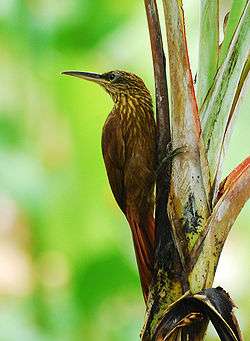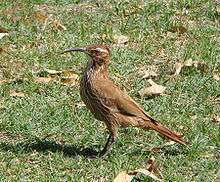Woodcreeper
| Woodcreepers | |
|---|---|
 | |
| Cocoa woodcreeper | |
| Scientific classification | |
| Kingdom: | Animalia |
| Phylum: | Chordata |
| Class: | Aves |
| Order: | Passeriformes |
| Suborder: | Tyranni |
| Family: | Furnariidae |
| Subfamily: | Dendrocolaptinae |
| Genera | |
|
Around 15–20, see article text | |
The woodcreepers (Dendrocolaptinae) comprise a subfamily of sub-oscine passerine birds endemic to the Neotropics. They have traditionally been considered a distinct family Dendrocolaptidae, but most authorities now place them as a subfamily of the ovenbirds (Furnariidae). They superficially resemble the Old World treecreepers, but they are unrelated and the similarities are due to convergent evolution. The subfamily contains around 57 species in 15 to 20 genera.
Woodcreepers range from 14 to 35 centimetres in length.[1] Generally brownish birds, the true woodcreepers maintain an upright vertical posture, supported by their stiff tail vanes.
They feed mainly on insects taken from tree trunks. However, woodcreepers often form part of the core group at the centre of flocks attending army ant swarms. Woodcreepers are arboreal cavity-nesting birds; two or three white eggs are laid and incubated for about 15 to 21 days.[1]
These birds can be difficult to identify in that they tend to have similar brown upperparts, and the more distinctive underparts are hard to see on a bird pressed against a trunk in deep forest shade. The bill shape, extend/shape of spots/streaks, and call are useful aids to determining species.
Description

The woodcreepers are generally fairly uniform in appearance. They range in size from 13 cm (the wedge-billed woodcreeper) to 35 cm in length (the strong-billed woodcreeper). Males tend to be slightly larger than females on average, but there is considerable overlap in size in most species. Pronounced sexual dimorphism in size and plumage is rare. Bill size and shape accounts for much of the variation between the species. Bills can be straight or highly decurved, and can account for as much as a quarter of the length of the bird (as happens in the long-billed woodcreeper). The plumage is usually subdued and often brown, or sometimes rufous or other dark colours. Many species have patterns such as checking, spotting or barring on their plumage. The feathers of the tail are rigid and are used for supporting the body when climbing tree trunks;[2] the tail can support most of the body weight and birds that lose their tail find climbing difficult. Woodcreepers climb by flexing their legs and hopping up the trunk. The feet of the woodcreepers are also modified for climbing. The front three toes are strongly clawed and the back tow is strong and long. The legs are also strong.[3]
Habitat and distribution

The woodcreepers are generally forest birds of Central and South America. Most species occur in rainforests, with the centre of diversity of the subfamily being the Amazon Basin. As many as 19 species of woodcreeper may co-occur in some areas of the Amazon, while in other rainforests, such as those in Costa Rica, the numbers are much lower. Other habitats used by the woodcreepers include pine-oak woodland, montane cloud forest, and pine forests. A few species inhabit savannah or other partly open environments, but they are absent from the temperate forests of the southern parts of South America.[3]
Behaviour
Diet and feeding
The woodcreepers are insectivores that are mostly arboreal in nature. Insects form the majority of the diet, with some spiders, centipedes, millipedes and even lizards being taken as well. A few specimens collected by scientists had fruit or seeds in their stomachs, but plant material is not thought to be regularly taken by any species. A few species forage on the ground, but most forage on the trunks of trees, on and on the underside of branches. They are generally solitary or occur in pairs, but frequently join mixed-species feeding flocks. The flocks they join are usually the lower level ones rather than canopy flocks, and are usually those insectivorous ones rather than frugivorous ones. Prey is almost always obtained by moving up the trunk or branch, and there are two main foraging techniques, probing and sallying. Probers investigate rough bark, mosses, masses of trapped dead leaves, bromeliads, and other areas where prey may be hiding, whereas those that sally launch into the air briefly to snatch prey that has been flushed by their movement. Several species regularly attend swarms of army ants to catch prey flushed by the ants.[4]
Systematics

The former family has been merged into the ovenbird family, Furnariidae, by most authorities. Analyses of mt and nDNA sequence data showed Sclerurus leaftossers and Geositta miners to be basal to the Furnariidae and the woodcreepers.[5] Maintaining Dendrocolaptidae as a separate family between them and the other furnariids created a paraphyletic Furnariidae, hence the merger. An alternative option was recommended by Moyle et al. (2009),[6] in which the woodcreepers maintain their status as a family, while the ovenbirds (as traditionally defined) are split into two families: Scleruridae and Furnariidae.
The xenops, which have usually been considered ovenbirds with a somewhat woodcreeper-like plumage, are problematic. They have recently been considered related to the woodcreepers,[7] while others have found them to be closer to the "traditional" ovenbirds.[6] If considered closer to the woodcreepers, they form a separate tribe and may give a good impression of how the ancestors of the woodcreepers must have looked like. The true woodcreepers are characterized by a belly feather growth pattern not found in any other birds.
The systematics of the Dendrocolaptinae were reviewed by Raikow (1994, based on morphology)[8] and Irestedt et al. (2004, based on analysis of nuclear and mitochondrial DNA sequences).[9] As the latter paper revealed, the commonplace convergent evolution of bill morphology hampered Raikow's analysis. Colour patterns, on the other hand, were more in agreement with the molecular data, but the generally drab colouration of the woodcreepers renders this character less informative than desirable. The work of Irested et al., on the other hand, was severely limited by unavailability of samples of many phylogenetically interesting taxa.
For example, the Deconychura species apparently belong into separate genera, but only D. longicauda was available for molecular analysis. Moving Lepidocolaptes fuscus to Xiphorhynchus restores monophyly of Lepidocolaptes, and Xiphorhynchus was very much under-split.[10][11] Hylexetastes may contain anything from one to four species.
It remains unresolved whether the scimitar-billed and long-billed woodcreepers' distinctiveness is due to strong selective pressure (and therefore rapid morphological evolution) of forms related to Lepidocolaptes and Dendrexetastes, respectively, or to long-time evolution of distinct lineages which separated early in the evolution of the group, with genetic similarity due to long branch attraction. The data gained from the myoglobin intron II DNA sequence disagrees strongly with mtDNA cytochrome b sequence data regarding the validity of Lepidocolaptes in general Irestedt et al. (2004);[9] as the latter agrees much better with morphological and biogeographical data it therefore is used here.
More detailed studies are needed to resolve these questions, namely re-evaluation of morphological data in the light of the molecular findings, and new molecular studies which thoroughly sample the questionable genera.
Additionally, the species-level taxonomy of several groups requires further study. Examples of "species" where vocal and morphological variations suggests that more than one species-level taxon could be involved are the curve-billed scythebill and the white-chinned, olivaceous, strong-billed and straight-billed woodcreepers.
FAMILY FURNARIIDAE
Subfamily Dendrocolaptinae – woodcreepers
Tribe Xenopini – xenops
- Genus Megaxenops
- Great xenops, Megaxenops parnaguae
- Genus Xenops
- Rufous-tailed xenops, Xenops milleri
- Slender-billed xenops, Xenops tenuirostris
- Plain xenops, Xenops minutus
- Streaked xenops, Xenops rutilans
Tribe Dendrocolaptini – true woodcreepers
- Genus Glyphorynchus
- Wedge-billed woodcreeper, Glyphorynchus spirurus
- Genus Dendrocincla
- Tyrannine woodcreeper, Dendrocincla tyrannina
- Thrush-like woodcreeper, Dendrocincla turdina
- Tawny-winged woodcreeper, Dendrocincla anabatina
- Plain-brown woodcreeper, Dendrocincla fuliginosa
- White-chinned woodcreeper, Dendrocincla merula
- Ruddy woodcreeper, Dendrocincla homochroa
- Genus Deconychura
- Long-tailed woodcreeper, Deconychura longicauda
- Spot-throated woodcreeper, Deconychura stictolaema – probably a genus on its own
- Genus Sittasomus
- Olivaceous woodcreeper, Sittasomus griseicapillus
- Genus Nasica
- Long-billed woodcreeper, Nasica longirostris
- Genus Dendrexetastes
- Cinnamon-throated woodcreeper, Dendrexetastes rufigula
- Genus Dendrocolaptes
- Northern barred woodcreeper, Dendrocolaptes sanctithomae
- Amazonian barred woodcreeper, Dendrocolaptes certhia
- Concolor woodcreeper, Dendrocolaptes (certhia) concolor
- Hoffmanns's woodcreeper, Dendrocolaptes hoffmannsi
- Black-banded woodcreeper, Dendrocolaptes picumnus
- Planalto woodcreeper, Dendrocolaptes platyrostris
- Genus Hylexetastes
- Bar-bellied woodcreeper, Hylexetastes stresemanni
- Red-billed woodcreeper, Hylexetastes perrotii
- Uniform woodcreeper, Hylexetastes (perrotii) uniformis
- Brigida's woodcreeper, Hylexetastes (perrotii) brigidai
- Genus Xiphocolaptes
- White-throated woodcreeper, Xiphocolaptes albicollis
- Moustached woodcreeper, Xiphocolaptes falcirostris
- Great rufous woodcreeper, Xiphocolaptes major
- Strong-billed woodcreeper, Xiphocolaptes promeropirhynchus
- Genus Campylorhamphus
- Greater scythebill, Campylorhamphus pucherani
- Red-billed scythebill, Campylorhamphus trochilirostris
- Brown-billed scythebill, Campylorhamphus pusillus
- Black-billed scythebill, Campylorhamphus falcularius
- Curve-billed scythebill, Campylorhamphus procurvoides
- Genus Dendroplex – formerly in Xiphorhynchus
- Straight-billed woodcreeper, Dendroplex picus
- Zimmer's woodcreeper, Dendroplex kienerii – formerly Xiphorhynchus necopinus
- Genus Xiphorhynchus (possibly polyphyletic)
- Lesser woodcreeper, Xiphorhynchus fuscus – formerly in Lepidocolaptes
- Spix's woodcreeper, Xiphorhynchus spixii
- Elegant woodcreeper, Xiphorhynchus elegans
- Juruá woodcreeper or Ihering's woodcreeper, Xiphorhynchus (elegans) juruanus
- Ocellated woodcreeper, Xiphorhynchus ocellatus
- Tschudi's woodcreeper, Xiphorhynchus (ocellatus) chunchotambo
- Chestnut-rumped woodcreeper, Xiphorhynchus pardalotus
- Striped woodcreeper, Xiphorhynchus obsoletus
- Spotted woodcreeper, Xiphorhynchus erythropygius
- Olive-backed woodcreeper, Xiphorhynchus triangularis
- Ivory-billed woodcreeper, Xiphorhynchus flavigaster
- Black-striped woodcreeper, Xiphorhynchus lachrymosus
- Buff-throated woodcreeper, Xiphorhynchus guttatus
- Lafresnaye's woodcreeper, Xiphorhynchus (guttatus) guttatoides
- Dusky-billed woodcreeper, Xiphorhynchus (guttatus/guttatoides) eytoni
- Lafresnaye's woodcreeper, Xiphorhynchus (guttatus) guttatoides
- Cocoa woodcreeper, Xiphorhynchus susurrans
- Lawrence's woodcreeper, Xiphorhynchus (susurrans) nanus
- Genus Drymornis
- Scimitar-billed woodcreeper, Drymornis bridgesii
- Genus Lepidocolaptes (12 species)
References
- 1 2 Willis, Edwin O. (1991). Forshaw, Joseph, ed. Encyclopaedia of Animals: Birds. London: Merehurst Press. p. 163. ISBN 1-85391-186-0.
- ↑ Tubaro, Pablo L.; Lijtmaer, Dario A.; Palacios, Maria G.; Kopuchian, Cecilia (2002). "Adaptive Modification of Tail Structure in Relation to Body Mass and Buckling in Woodcreepers". The Condor 104 (2): 281–296. doi:10.1650/0010-5422(2002)104[0281:AMOTSI]2.0.CO;2. JSTOR 1370031.
- 1 2 Remsen, J. Van (2003): Family Dendrocolaptidae (Woodcreepers). In: del Hoyo, Josep; Elliott, Andrew & Sargatal, Jordi (editors): Handbook of Birds of the World, Volume 6: Broadbills to Tapaculos: 358–447. Lynx Edicions, Barcelona. ISBN 84-87334-50-4
- ↑ Willis, E.; Oniki, Y. (1978). "Birds and Army Ants". Annual Review of Ecology and Systematics 9: 243–263. doi:10.1146/annurev.es.09.110178.001331. JSTOR 2096750.
- ↑ Irestedt, Martin; Fjeldså, Jon; Johansson, Ulf S.; Ericson, Per G.P. (2002). "Systematic relationships and biogeography of the tracheophone suboscines (Aves: Passeriformes)". Molecular Phylogenetics and Evolution 23 (3): 499–512. doi:10.1016/S1055-7903(02)00034-9. PMID 12099801.
- 1 2 Moyle, R. G.; Chesser, R. T.; Brumfield, R. T.; Tello, J. G.; Marchese, D. J.; Cracraft, J. (2009). "Phylogeny and phylogenetic classification of the antbirds, ovenbirds, woodcreepers, and allies (Aves: Passeriformes: infraorder Furnariides)". Cladistics 25 (4): 386–405. doi:10.1111/j.1096-0031.2009.00259.x.
- ↑ Fjeldså, Jon; Irestedt, Martin; Ericson, Per G. P. (2005). "Molecular data reveal some major adaptational shifts in the early evolution of the most diverse avian family, the Furnariidae" (PDF). Journal of Ornithology 146: 1–13. doi:10.1007/s10336-004-0054-5.
- ↑ Raikow, Robert J. (1994). "A phylogeny of the woodcreepers (Dendrocolaptinae)" (PDF). Auk 111 (1): 104–114. doi:10.2307/4088509.
- 1 2 Irestedt, Martin; Fjeldså, Jon; Ericson, Per G. P. (2004). "Phylogenetic relationships of woodcreepers (Aves: Dendrocolaptinae) – incongruence between molecular and morphological data" (PDF). Journal of Avian Biology 35 (3): 280–288. doi:10.1111/j.0908-8857.2004.03234.x.
- ↑ Aleixo, Alexandre (2002). Molecular systematics, phylogeography, and population genetics of Xiphorhynchus (Aves: Dendrocolaptidae) in the Amazon basin (PDF). Ph.D. dissertation, Louisiana State University, Baton Rouge, LA.
- ↑ Aleixo, Alexandre (2002). "Molecular Systematics and the Role of the "Várzea"-"Terra-Firme" Ecotone in the Diversification of Xiphorhynchus Woodcreepers (Aves: Dendrocolaptidae)". Auk 119 (3): 621–640. doi:10.1642/0004-8038(2002)119[0621:MSATRO]2.0.CO;2.
External links
- Woodcreeper videos on the Internet Bird Collection
- Woodcreeper sounds on xeno-canto.org